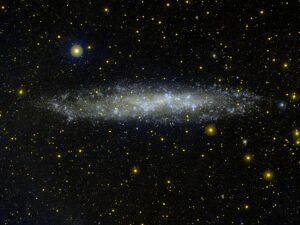Astronomy:NGC 3109
| NGC 3109 | |
|---|---|
 NGC 3109 by GALEX (ultraviolet) | |
| Observation data (J2000 epoch) | |
| Constellation | Hydra |
| Right ascension | 10h 03m 06.9s[1] |
| Declination | −26° 09′ 34″[1] |
| Redshift | 403 ± 1 km/s[1] |
| Distance | 1.333 ± 0.19 Mpc (4.348 ± 0.6197 Mly)[2][3] |
| Apparent magnitude (V) | 10.4[1] |
| Characteristics | |
| Type | SB(s)m[1] |
| Size | 41,748 ly × 8,773.6 ly (12.80 kpc × 2.69 kpc) (diameter; ESO D25.5 B-band isophote)[4][lower-alpha 1] 3,946 ly × 3,946 ly (1.21 kpc × 1.21 kpc) (diameter; 2MASS K-band total isophote)[4][lower-alpha 1] |
| Apparent size (V) | 19.1′ × 3.7′[1] |
| Other designations | |
| UGCA 194, PGC, 29128,[1] h 3221, GC 2003[5] | |
NGC 3109 is a small barred Magellanic type spiral or irregular galaxy around 4.35 Mly away in the direction of the constellation of Hydra. NGC 3109 is believed to be tidally interacting with the dwarf elliptical galaxy Antlia Dwarf.[6] It was discovered by John Herschel on March 24, 1835 while he was in what is now South Africa .[5]
Size and morphology
NGC 3109 is classified as a Magellanic type irregular galaxy,[7] but it may in fact be a small spiral galaxy. Based on the D25.5 isophote at the B-band with an angular diameter of 1,980 arcseconds, it has an isophotal diameter approximately 12.80 kiloparsecs (41,700 light-years) across, slightly larger than the Large Magellanic Cloud but smaller than the Triangulum Galaxy.[1] If it is a spiral galaxy, it would be the smallest in the Local Group.[8] NGC 3109 has a mass of about 2.3×109 times the mass of the Sun (M☉), of which 20% is in the form of neutral hydrogen.[9] It is oriented edge-on from our point of view, and may contain a disk and a halo.[8] The disk appears to be composed of stars of all ages, whereas the halo contains only very old and metal-poor stars.[10] NGC 3109 does not appear to possess a galactic nucleus.[9]
From measurements of the neutral atomic hydrogen in the galaxy, it has been found that the disk of NGC 3109 is warped. The warp has the same radial velocity as gas in the Antlia Dwarf galaxy, indicating that the two galaxies had a close encounter approximately one billion years ago.[11]
Composition
Based on spectroscopy of blue supergiants in NGC 3109, it is known that the galaxy has a low metallicity, similar to that to the Small Magellanic Cloud.[12] It is one of the most metal-poor star-forming galaxies in the Local group.[13] NGC 3109 seems to contain an unusually large number of planetary nebulae for its luminosity.[14] It also contains a substantial amount of dark matter.[15]
Location
NGC 3109 is located about 1.33 megaparsecs (4.3 Mly) away, in the constellation Hydra. This puts it at the very outskirts of the Local Group.[12] Its membership of the Local Group has been questioned, because it seems to be receding faster than estimates of the Local Group's escape velocity.[16] It is distant enough from the largest members of the Local Group that it has not been tidally influenced by them.[13]
Gallery
NGC 3109 with Hubble
NGC 3109 with the legacy surveys
Notes
References
- ↑ 1.0 1.1 1.2 1.3 1.4 1.5 1.6 1.7 "NASA/IPAC Extragalactic Database". Results for NGC 3109. http://nedwww.ipac.caltech.edu/.
- ↑ I. D. Karachentsev; V. E. Karachentseva; W. K. Hutchmeier; D. I. Makarov (2004). "A Catalog of Neighboring Galaxies". Astronomical Journal 127 (4): 2031–2068. doi:10.1086/382905. Bibcode: 2004AJ....127.2031K.
- ↑ Karachentsev, I. D.; Kashibadze, O. G. (2006). "Masses of the local group and of the M81 group estimated from distortions in the local velocity field". Astrophysics 49 (1): 3–18. doi:10.1007/s10511-006-0002-6. Bibcode: 2006Ap.....49....3K.
- ↑ 4.0 4.1 "Detailed Information for Object NGC 3109". NASA/IPAC Extragalactic Database. https://ned.ipac.caltech.edu/cgi-bin/objsearch?objname=NGC+3109&extend=no&hconst=67.74&omegam=0.3089&omegav=0.6911&corr_z=1&out_csys=Equatorial&out_equinox=J2000.0&obj_sort=RA+or+Longitude&of=pre_text&zv_breaker=30000.0&list_limit=5&img_stamp=YES.
- ↑ 5.0 5.1 Irregular Galaxy NGC 3109
- ↑ Grebel, Gallagher, Harbeck, p.7
- ↑ Aparicio, Antonio; Artemio Herrero; F. Sánchez (1998). Stellar astrophysics for the local group: VIII Canary Islands Winter School. University of Cambridge. p. 286. ISBN 978-0-521-63255-3. https://books.google.com/books?id=3gn5hS2zIkcC&pg=PA286.
- ↑ 8.0 8.1 Sauvage, Marc; Grazyna Stasinska; Daniel Schaerer (2002). The evolution of galaxies: II—basic building blocks, Volume 2. Kluwer Academic Publishers. pp. 123, 124. ISBN 978-1-4020-0622-7. https://books.google.com/books?id=xAPX8UfT6qAC&q=ngc+3109&pg=PA123.
- ↑ 9.0 9.1 van den bergh, Sidney (2000). The galaxies of the Local Group. University of Cambridge. pp. 265. ISBN 978-0-521-65181-3. https://books.google.com/books?id=NfOwG3cyAGIC&pg=PA265.
- ↑ Hidalgo, Sebastian L. (2008). "The Disc-Halo Structure of NGC 3109". The Astronomical Journal 136 (6): 2332–2342. doi:10.1088/0004-6256/136/6/2332. Bibcode: 2008AJ....136.2332H.
- ↑ Barnes, D. G.; de Blok, W. J. G. (August 2001). "On the Neutral Gas Content and Environment of NGC 3109 and the Antlia Dwarf Galaxy". The Astronomical Journal 122 (2): 825. doi:10.1086/321170. Bibcode: 2001AJ....122..825B.
- ↑ 12.0 12.1 Evans, Chris (2006). "The ARAUCARIA Project – First Observations of Blue Supergiants in NGC 3109". The Messenger 126: 5. Bibcode: 2006Msngr.126....5E. http://www.eso.org/sci/publications/messenger/archive/no.126-dec06/messenger-no126-5-6.pdf. Retrieved 2010-09-24.
- ↑ 13.0 13.1 Pena, M.. "An interesting comparison between PNE and H II regions in NGC 3109 and NGC 6822". Revista Mexicana de Astronomía y Astrofísica 35: 74–75. http://www.astroscu.unam.mx/rmaa/RMxAC..35/PDF/RMxAC..35_mpena.pdf. Retrieved 2010-09-24.
- ↑ Richer, Michael G.; Marshall L. McCall (1992). "Planetary nebulae and H II regions in NGC 3109". The Astronomical Journal 103: 54–59. doi:10.1086/116040. Bibcode: 1992AJ....103...54R.
- ↑ Jobin, Marc; Carignan, Claude (1990). "The dark side of NGC 3109". The Astronomical Journal 100 (3): 648–662. doi:10.1086/115548. Bibcode: 1990AJ....100..648J.
- ↑ Plotner, Tammy (2009-05-18). "Turning the Tides – NGC 3109 by Ken Crawford". Universe Today. http://www.universetoday.com/27388/turning-the-tides-ngc-3109-by-ken-crawford/.
Further reading
- Grebel, Gallagher, Harbeck (2003) The Progenitors of Dwarf Spheroidal Galaxies ArXiv.org. retrieved November 2007
External links
- NGC 3109 on WikiSky: DSS2, SDSS, GALEX, IRAS, Hydrogen α, X-Ray, Astrophoto, Sky Map, Articles and images
Coordinates: ![]() 10h 03m 06.9s, −26° 09′ 34″
10h 03m 06.9s, −26° 09′ 34″
 |



